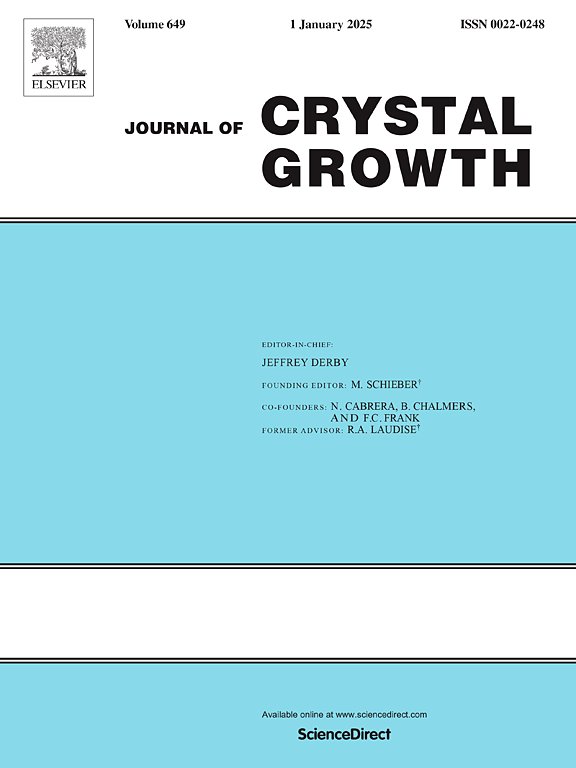合成温度在通过溶胶-凝胶工艺形成氧化锌纳米粒子中的作用
IF 1.7
4区 材料科学
Q3 CRYSTALLOGRAPHY
引用次数: 0
摘要
本研究探讨了在 25 °C 和 60 °C 温度条件下通过溶胶-凝胶法合成氧化锌粉末的过程。采用标准技术进行了表征,以研究这些温度条件如何影响所得材料的物理化学特性。XRD 分析证实,该材料具有高结晶度和纯正的六方菱镁矿结构,25 ℃ 和 60 ℃ 时的平均结晶尺寸分别约为 20 nm 和 38 nm。扫描电子显微镜(SEM)和透射电子显微镜(TEM)技术分别在 25 °C 和 60 °C 时确定了针状纳米棒和纳米花状结构。对 Zn2p 和 O1s 光电子线的高分辨率 XPS 光谱进行分析后发现,Zn(II) 状态占主导地位,在温度较高时,ZnO 的贡献率从 14.6% 增加到 41.6%。伴随这一变化的是缺陷氧和水分含量的减少。此外,DSC 分析表明,在 25 ℃ 和 60 ℃ 下合成的氧化锌粉末的热特性存在显著差异,在 120 ℃ 左右出现明显的内热峰,与合成过程中所用溶剂的蒸发相对应。与 60°C 合成相比,25°C 合成所需的相变能量明显更高,表明热稳定性和能量需求更高。本文章由计算机程序翻译,如有差异,请以英文原文为准。
Role of synthesis temperature in the formation of ZnO nanoparticles via the Sol-Gel process
This study examines the synthesis of ZnO powder via the sol–gel method at temperatures of 25 °C and 60 °C. Characterization was conducted using standard techniques to investigate how these temperature conditions influence the physicochemical properties of the resulting material. XRD analysis confirmed high crystallinity with a pure hexagonal wurtzite structure, with average crystallite sizes of approximately 20 nm at 25 °C and 38 nm at 60 °C. Both SEM and TEM techniques established needle-like nanorods at 25 °C and nanoflower-like structures at 60 °C. Analyzing the high-resolution XPS spectra of the Zn2p and O1s photoelectron lines revealed a predominant Zn(II) state, with the contribution of ZnO increasing from 14.6 at.% to 41.6 at.% at higher temperatures. This change was accompanied by a decrease in defective oxygen and water content. Furthermore, DSC analysis revealed significant differences in thermal properties of ZnO powders synthesized at 25 °C and 60 °C, with distinct endothermic peaks around 120 °C corresponding to the evaporation of the solvent used in the synthesis process. The energy required for phase transitions was notably higher for the 25 °C synthesis, indicating greater thermal stability and energy demands compared to the 60 °C synthesis.
求助全文
通过发布文献求助,成功后即可免费获取论文全文。
去求助
来源期刊

Journal of Crystal Growth
化学-晶体学
CiteScore
3.60
自引率
11.10%
发文量
373
审稿时长
65 days
期刊介绍:
The journal offers a common reference and publication source for workers engaged in research on the experimental and theoretical aspects of crystal growth and its applications, e.g. in devices. Experimental and theoretical contributions are published in the following fields: theory of nucleation and growth, molecular kinetics and transport phenomena, crystallization in viscous media such as polymers and glasses; crystal growth of metals, minerals, semiconductors, superconductors, magnetics, inorganic, organic and biological substances in bulk or as thin films; molecular beam epitaxy, chemical vapor deposition, growth of III-V and II-VI and other semiconductors; characterization of single crystals by physical and chemical methods; apparatus, instrumentation and techniques for crystal growth, and purification methods; multilayer heterostructures and their characterisation with an emphasis on crystal growth and epitaxial aspects of electronic materials. A special feature of the journal is the periodic inclusion of proceedings of symposia and conferences on relevant aspects of crystal growth.
 求助内容:
求助内容: 应助结果提醒方式:
应助结果提醒方式:


